
Phallaceae is a family of fungi, commonly known as stinkhorns, within the order Phallales. Stinkhorns have a worldwide distribution, but are especially prevalent in tropical regions. They are known for their foul-smelling, sticky spore masses, or gleba, borne on the end of a stalk called the receptaculum. The characteristic fruiting-body structure, a single, unbranched receptaculum with an externally attached gleba on the upper part, distinguishes the Phallaceae from other families in the Phallales. The spore mass typically smells of carrion or dung, and attracts flies, beetles and other insects to help disperse the spores. Although there is great diversity in body structure shape among the various genera, all species in the Phallaceae begin their development as oval or round structures known as "eggs". The appearance of Phallaceae is often sudden, as gleba can erupt from the underground egg and burst open within an hour. According to a 2008 estimate, the family contains 21 genera and 77 species.

The Cladoniaceae are a family of lichenized fungi in the order Lecanorales. It is one of the largest families of lichen-forming fungi, with about 560 species distributed amongst 17 genera. The reindeer moss and cup lichens (Cladonia) belong to this family. The latter genus, which comprises about 500 species, forms a major part of the diet of large mammals in taiga and tundra ecosystems. Many Cladoniaceae lichens grow on soil, but other can use decaying wood, tree trunks, and, in a few instances, rocks as their substrate. They grow in places with high humidity, and cannot tolerate aridity.

Ophrys insectifera, the fly orchid, is a species of orchid and the type species of the genus Ophrys. It is remarkable as an example of the use of sexually deceptive pollination and floral mimicry, as well as a highly selective and highly evolved plant–pollinator relationship.

Entoloma is a genus of fungi in the order Agaricales. Called pinkgills in English, basidiocarps are typically agaricoid, though a minority are gasteroid. All have salmon-pink basidiospores which colour the gills at maturity and are angular (polyhedral) under a microscope. The genus is large, with almost 2000 species worldwide. Most species are saprotrophic, but some are ectomycorrhizal, and a few are parasitic on other fungi. The type, Entoloma sinuatum, is one of several Entoloma species that are poisonous, typically causing mild to severe gastrointestinal illness.

Laricifomes officinalis, also known as agarikon, eburiko, or the quinine conk, is a wood-decay fungus that causes brown heart rot on conifers native to Europe, Asia, and North America, as well as Morocco. This fungus is the only member of the genus Laricifomes, in the order Polyporales. The fruiting bodies grow in large conks on the trunks of trees.
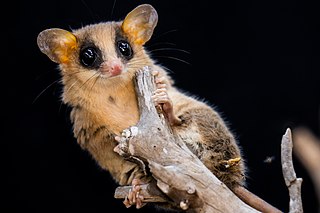
Gracilinanus is a genus of opossum in the family Didelphidae. It was separated from the genus Marmosa in 1989, and has since had the genera Cryptonanus, Chacodelphys, and Hyladelphys removed from it.
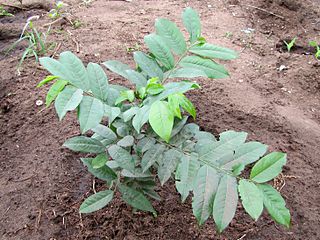
Mkilua is a genus of plant in the family Annonaceae. It is native to Kenya and Tanzania. It contains a single species, Mkilua fragrans. Bernard Verdcourt, the British botanist who first formally described the species, named it after the fragrance of its flowers which smell like lemon. It is commonly called Mkilua Mwitu, Kilua and Kiluwa in Swahili, and Kingade in Digo. Volatile oils extracted from its leaves, flowers, and aerial parts have been reported to be repellent to Anopheles gambiae mosquitoes which are vectors for the malaria parasite Plasmodium falciparum. Bioactive molecules extracted from its roots have been reported to have antimicrobial activity in tests with Streptococcus agalactiae and Staphylococcus aureus.

The Peltigeraceae are a family of lichens in the order Peltigerales. The Peltigeraceae, which contains 15 genera and about 600 species, has recently (2018) been emended to include the families Lobariaceae and Nephromataceae. Many Peltigeraceae species have large and conspicuous, leathery thalli. They largely occur in cool-temperate to tropical montane climates. Tripartite thalli involving fungus, green algae and cyanobacteria are common in this family.

Clathrus ruber is a species of fungus in the family Phallaceae, and the type species of the genus Clathrus. It is commonly known as the latticed stinkhorn, the basket stinkhorn, or the red cage, alluding to the striking fruit bodies that are shaped somewhat like a round or oval hollow sphere with interlaced or latticed branches. The fungus is saprobic, feeding off decaying woody plant material, and is often found alone or in groups in leaf litter on garden soil, grassy places, or on woodchip garden mulches. Although considered primarily a European species, C. ruber has been introduced to other areas, and now has a wide distribution that includes all continents except Antarctica. The species was illustrated in the scientific literature during the 16th century, but was not officially described until 1729.
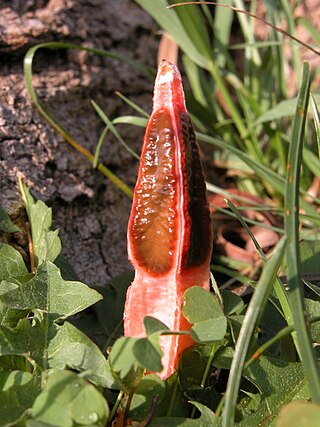
Lysurus mokusin, commonly known as the lantern stinkhorn, the small lizard's claw, or the ribbed lizard claw, is a saprobic species of fungus in the family Phallaceae. The fruit body consists of a reddish, cylindrical fluted stipe that is capped with several "arms". The arms can approach or even close in on each other to form a spire. The gleba—an olive-green slimy spore mass—is carried on the outer surface of the arms. The fruit body, which has an odor comparable to "fresh dog feces", "rotting flesh", or "sewage" when mature, is edible in its immature "egg" stage. The fungus is native to Asia, and is also found in Australia, Europe and North America, where it is probably an introduced species. It has been used medicinally in China as an ulcer remedy.
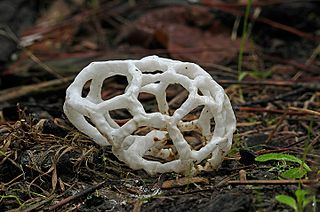
Ileodictyon cibarium is a saprotrophic species of fungus in the family Phallaceae. It is native to Australia and New Zealand, where it is commonly known as the basket fungus or the white basket fungus, alluding to its fruit bodies, shaped like a round or oval ball with interlaced or latticed branches, resembling polyhedra similar to closed fullerenes. Although the immature spherical fruitbodies are reportedly edible, the mature fruit body is foul-smelling and partly covered with a slime layer containing spores (gleba) on the inner surfaces.

Mitrulinia is a fungal genus of uncertain familial placement in the order Helotiales. Mitrulinia is a monotypic genus, containing the single species Mitrulinia ushuaiae. The genus was circumscribed in 1987 by mycologist Brian Spooner.

Texosporium is a genus of lichenized fungi in the family Caliciaceae. It is a monotypic genus, containing the single species Texosporium sancti-jacobi, found in the United States. The genus is characterized by microscopic features: the ascospores are coated with a layer of cells that are derived from the paraphyses. Texosporium was originally circumscribed by Josef Nádvorník in 1942, albeit the name was not validly published. In 1968, Leif Tibell and Angelica van Hofsten published the name validly. In 2020, Texosporium sancti-jacobi was added to the global IUCN Red List, where it is classified as endangered.

Clavaria zollingeri, commonly known as the violet coral or the magenta coral, is a widely distributed species of fungus. It produces striking tubular, purple to pinkish-violet fruit bodies that grow up to 10 cm (3.9 in) tall and 7 cm (2.8 in) wide. The extreme tips of the fragile, slender branches are usually rounded and brownish. A typical member of the clavarioid or club fungi, Clavaria zollingeri is saprobic, and so derives nutrients by breaking down organic matter. The fruit bodies are typically found growing on the ground in woodland litter, or in grasslands. Variations in branching and color can often be used to distinguish C. zollingeri from similarly colored coral fungi such as Alloclavaria purpurea and Clavulina amethystina, although microscopy is required to reliably identify the latter species.
Lepiota viridigleba is a species of sequestrate fungus in the family Agaricaceae. It was first described as new to science by mycologist Michael Castellano in 1995, based on collections made among Populus roots in California. The fungus was initially called Amogaster viridiglebus and tentatively placed in the order Boletales. Molecular analysis revealed the fungus to be a member of the genus Lepiota, and it was transferred to that genus in 2013.
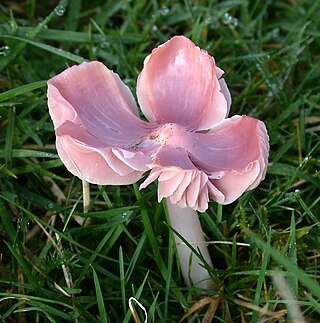
Porpolomopsis calyptriformis, commonly known as the pink wax cap, ballerina waxcap or salmon waxy cap, is a species of agaric in the family Hygrophoraceae. The species has a European distribution, occurring mainly in agriculturally unimproved grassland. Threats to its habitat have resulted in the species being assessed as globally "vulnerable" on the IUCN Red List of Threatened Species. A similar but as yet unnamed species occurs in North America.
Bulbophyllum nocturnum is a species of epiphytic orchid that grows in New Britain. It was described in 2011, and is the first species of orchid known to consistently flower during the night, and close its flowers during the day.

Gracile capuchin monkeys are capuchin monkeys in the genus Cebus. At one time all capuchin monkeys were included within the genus Cebus. In 2011, Jessica Lynch Alfaro et al. proposed splitting the genus between the robust capuchin monkeys, such as the tufted capuchin, and the gracile capuchins. The gracile capuchins retain the genus name Cebus, while the robust species have been transferred to Sapajus.

Colus pusillus is a species of fungus in the family Phallaceae. It is found in Australia. It is sometimes known as the craypot stinkhorn or basket stinkhorn, a reference to the unique appearance of the fruiting bodies which consist of vivid red, wrinkled arms that branch and connect to form a cage-like structure reminiscent to that of the related species Clathrus ruber. This fungus is saprobic and makes frequent appearances on garden mulch as a result.

Ileodictyon gracile is a saprotrophic species of fungus in the family Phallaceae. It is native to Australia, where it is commonly known as the smooth cage fungus, with reference to its basidiocarps, shaped like a ball with interlaced or latticed branches partly covered on the inner surfaces with a foetid slime layer containing basidiospores.


















